Sardinian fregola, with its small toasted grains similar to couscous, boasts an ancient and fascinating history. Born in Sardinia centuries ago, it is said to be even older than bread!
This island, with its crystal-clear sea, white beaches, and intense scents of Mediterranean scrub, offered me an unforgettable culinary experience: the first taste of fregola with clams.
I still remember that hot summer afternoon, in a small seaside restaurant, with outdoor tables overlooking the beach. The air smelled of salt and toasted fregola, while the creamy sauce, carefully and passionately prepared, enveloped the freshest clams, releasing an irresistible aroma. A flavor explosion that won me over at the first bite!
Since then, this dish has rightfully become one of my favorites, and today I want to share with you my easy and quick recipe, to bring a bit of that Sardinian magic to your tables too!
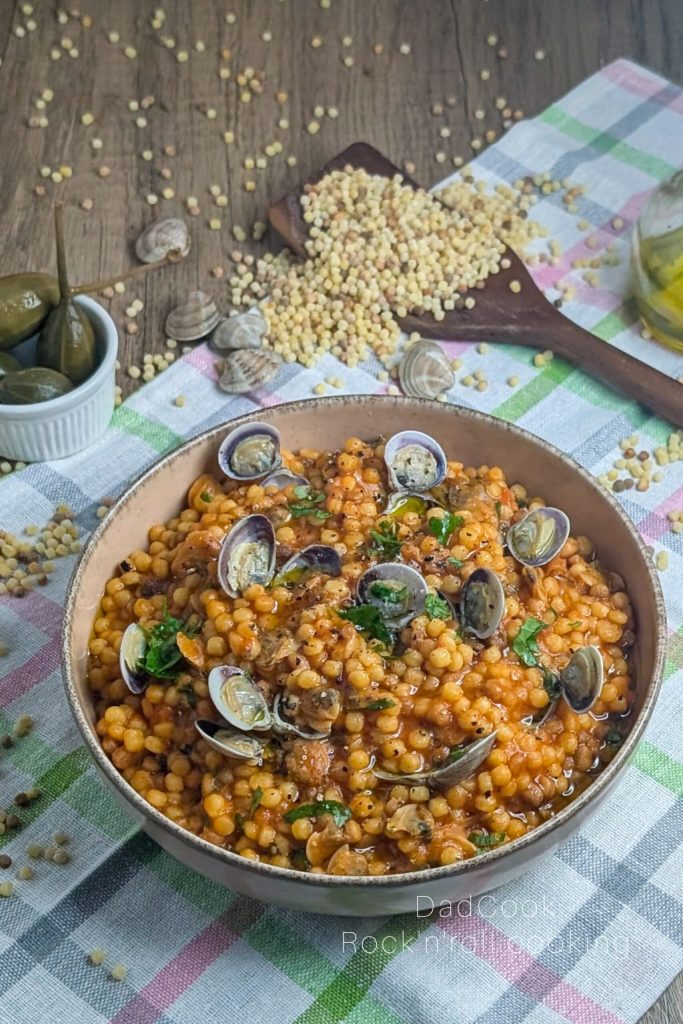
- Difficulty: Very Easy
- Cost: Affordable
- Rest time: 5 Minutes
- Preparation time: 20 Minutes
- Portions: 4
- Cooking methods: Stove
- Cuisine: Italian
- Seasonality: Spring, Summer, All Saints
- Energy 157.45 (Kcal)
- Carbohydrates 22.91 (g) of which sugars 1.08 (g)
- Proteins 9.42 (g)
- Fat 3.44 (g) of which saturated 0.89 (g)of which unsaturated 2.01 (g)
- Fibers 0.85 (g)
- Sodium 581.14 (mg)
Indicative values for a portion of 210 g processed in an automated way starting from the nutritional information available on the CREA* and FoodData Central** databases. It is not food and / or nutritional advice.
* CREATES Food and Nutrition Research Center: https://www.crea.gov.it/alimenti-e-nutrizione https://www.alimentinutrizione.it ** U.S. Department of Agriculture, Agricultural Research Service. FoodData Central, 2019. https://fdc.nal.usda.gov
Ingredients
- 12.7 oz fregola
- 2.2 lbs clams (Arselle or Lupino)
- 9.9 oz peeled tomato
- 1 clove garlic
- 1 bunch parsley
- 1 drizzle extra virgin olive oil
- to taste black pepper
- to taste salt
- 1 glass white wine (Dry)
Tools
- 1 Pan Lagostina
- 1 Saucepan Vier
Steps
Preparation and cooking of clams:
Before starting, soak the clams in a bowl with cold water and coarse salt for at least 2 hours, changing the water a couple of times. This step is crucial to purge the clams, meaning to expel the sand they might contain.
After the soaking time, rinse them thoroughly under cold running water, rubbing them together to remove any remaining debris. In a large pan, heat a drizzle of extra virgin olive oil with a slightly crushed garlic clove and a sprig of parsley.
Add the drained clams, cover with a lid, and cook over high heat until they open, stirring occasionally.
At this point, deglaze with a glass of dry white wine (if using), let the alcohol evaporate, and turn off the heat.

Cleaning and filtering:
With a slotted spoon, remove the clams from the pan and shell them carefully, keeping some with shells aside for plate decoration.
Filter the clam cooking water several times with a fine-mesh sieve or cheesecloth to remove any sand residue.
This liquid, rich in flavor, will be essential for cooking the fregola and giving it an intense sea aroma.

Toasting and starting to cook the fregola:
In a thick-bottomed pot (ideally a saucepan), dry-toast the fregola for a few minutes, constantly stirring with a wooden spoon, just as you would with risotto.
This step will make the fregola more crunchy and enhance its flavor.
Add the peeled tomatoes (or fresh tomatoes chopped into pieces) and let them season for a few minutes, stirring. Begin cooking the fregola by adding hot water ladles, little by little, as if preparing a risotto, stirring often to prevent it from sticking to the bottom.
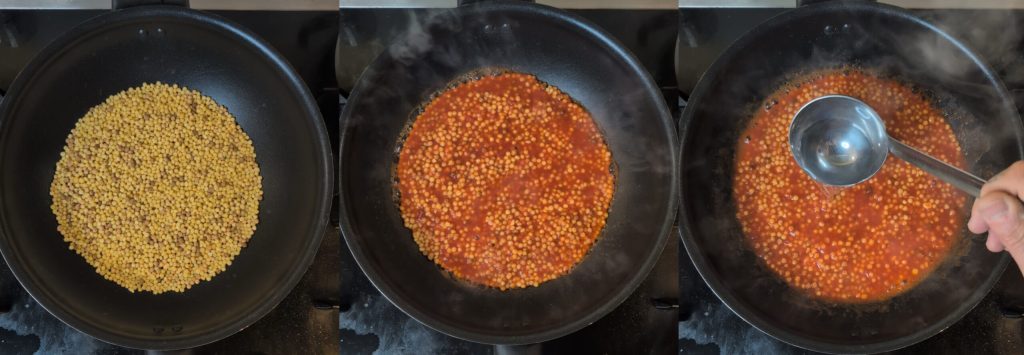
Cooking with clam broth and creaming:
When the fregola is halfway cooked, begin adding the filtered clam broth, one ladle at a time, continuing to stir.Also add the shelled clams and season with salt and black pepper to taste. Continue cooking until the fregola is al dente, adding more broth if necessary.
Taste and adjust salt if needed.
With the heat off, cream the fregola with a drizzle of raw extra virgin olive oil to blend the flavors well and make it creamier.

Plating and serving:
Let the fregola rest for a few minutes so the flavors meld further.Plate the fregola with clams, decorating with the reserved clams with shells, a sprinkle of finely chopped fresh parsley, and a pinch of black pepper.
Serve immediately and enjoy your dish of fregola with clams, perhaps accompanied by a good glass of fresh white wine!

Here are some tips, variations, and suggestions for storing your fregola with clams:
Tips:
Quality of ingredients: Choose the freshest and highest quality clams, preferably from sustainable fishing. Good quality Sardinian fregola will make a difference in the final result.
Purge: Do not skip the purging phase of the clams, it is essential to avoid finding sand in the dish!
Toasting: Toasting the fregola dry before starting to cook will make it more crunchy and flavorful.
Clam broth: Use the filtered clam cooking broth to cook the fregola, it will give the dish a more intense sea flavor.
Creaming: Creaming the fregola with a drizzle of raw oil after turning off the heat will make the dish creamier and more flavorful.
Cooking time: Taste the fregola during cooking to check that it is al dente. The cooking time may vary slightly depending on the type of fregola used.
Variations:
With bottarga: Add grated bottarga at the end of cooking for an even more intense flavor touch.
With saffron: Add a pinch of saffron to the cooking broth for an extra touch of color and flavor.
With cherry tomatoes: Add fresh cherry tomatoes halved or chopped during the cooking of clams for a touch of freshness and color.
With chili: Add a pinch of fresh or dried chili for a spicy touch.
With other seafood: You can enrich the recipe with other seafood, like mussels, shrimp, or squid.
Storage:
In the fridge: Fregola with clams can be stored in the fridge for up to 2 days, in an airtight container.
Freezing: It is possible to freeze the cooked fregola with clams. Thaw it in the fridge and then reheat it in a pan with a drizzle of oil and a bit of vegetable broth.
Reheating: To reheat fregola with clams, use a non-stick pan with a drizzle of oil and a bit of vegetable broth, so as not to dry it out too much.
I hope these tips are helpful to you! 😊
Here are some wine pairing suggestions for your Creamy Fregola with Clams:
Wines:
Vermentino di Sardegna: A timeless classic, with its mineral notes and freshness, it perfectly complements the sea flavors and the delicacy of the fregola.
Vermentino di Gallura DOCG: Even more fragrant and structured than Vermentino di Sardegna, with notes of white flowers and white-fleshed fruit, it is an excellent choice to enhance the creaminess of the dish.
Nuragus di Cagliari DOC: If you prefer a softer and more aromatic wine, Nuragus is ideal. With its almond and honey notes, it pairs well with fregola and clams, creating a balance of flavors.
Vernaccia di Oristano DOC: For those who love more complex and structured wines, Vernaccia, with its oxidative notes and intense flavor, offers an interesting and original pairing.
Fiano di Avellino: Moving out of Sardinia, Fiano di Avellino, with its minerality and notes of dried fruit and citrus, pairs well with fregola with clams, creating an interesting aromatic counterpoint.
Serve the wine chilled, at about 50-54°F.
Choose a wide glass to allow the wine to oxygenate and release its aromas.
If you want to experiment, you can also try other Italian white wines, like Verdicchio dei Castelli di Jesi or Greco di Tufo.
Cheers! 🥂
FAQ (Frequently Asked Questions)
What is fregola?
Fregola is a type of semolina pasta typical of Sardinia. It is shaped like couscous but has a unique toasted flavor due to the artisanal process of oven toasting.
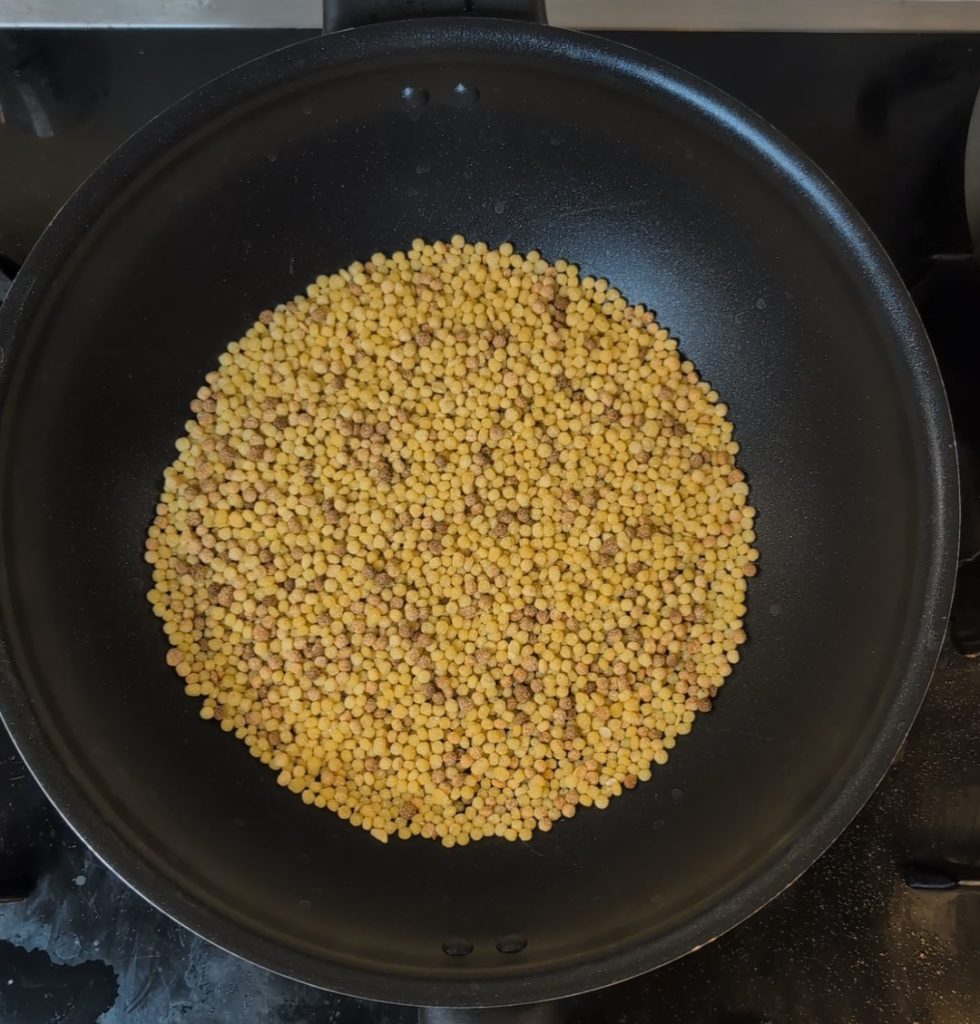
What is the difference between fregola and couscous?
The main difference lies in the ingredients and processing. Fregola is made from durum wheat semolina, while couscous is made from soft wheat semolina. Additionally, fregola is toasted in the oven, giving it a more intense flavor and crunchier texture.
How do you purge the clams?
To purge clams, place them in a bowl with cold water and coarse salt (about 1 oz per quart of water) for at least 2 hours. It is important to change the water a couple of times during this period. This way, the clams will expel the sand they might contain.
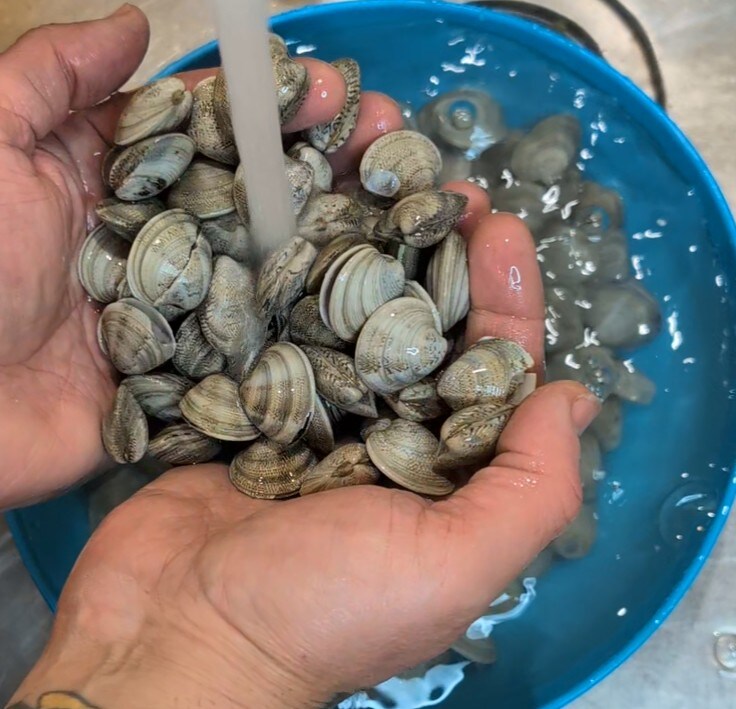
Can I use arselle instead of clams?
Sure! You can use arselle (or lupins) instead of clams. They have a more delicate and slightly sweet flavor but pair very well with fregola.
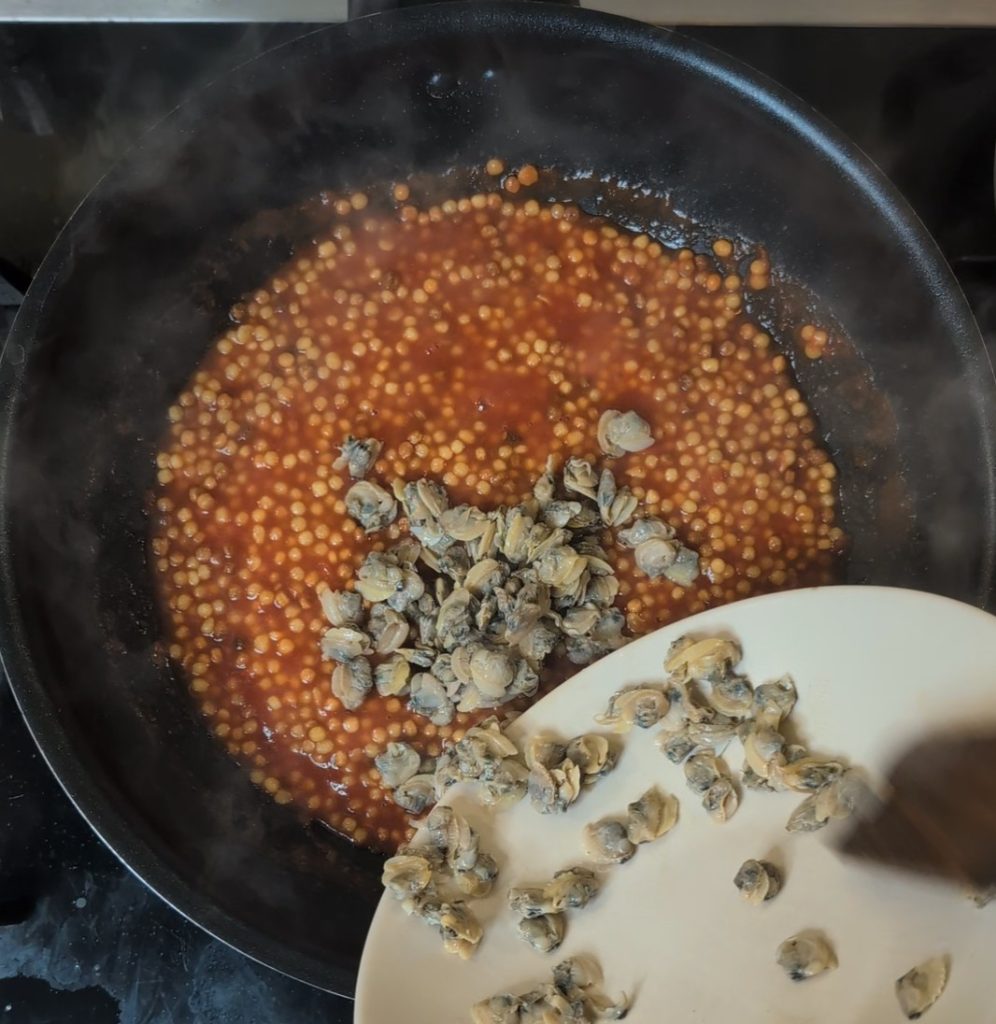
What can I add to fregola with clams to enrich the dish?
You can add fresh cherry tomatoes, saffron, grated bottarga, a pinch of chili, or other seafood like mussels or shrimp.

How can you tell if the fregola is cooked?
Fregola is cooked when it is al dente, meaning soft but still slightly firm to the bite. Taste it during cooking to check the texture.
How do you store leftover fregola with clams?
Fregola with clams can be stored in the fridge for up to 2 days in an airtight container.
Can I freeze fregola with clams?
Yes, you can freeze cooked fregola with clams. Thaw it in the fridge and then reheat it in a pan with a drizzle of oil and a bit of vegetable broth.
What wine can I pair with fregola with clams?
Sardinian white wines, such as Vermentino and Nuragus, are perfect for accompanying fregola with clams. Alternatively, you can try Fiano di Avellino or Verdicchio.
Is it a difficult dish to prepare?
No, fregola with clams is a fairly simple dish to prepare, just follow the recipe step by step and pay attention to some details, such as the purging of the clams and the cooking of the fregola.


